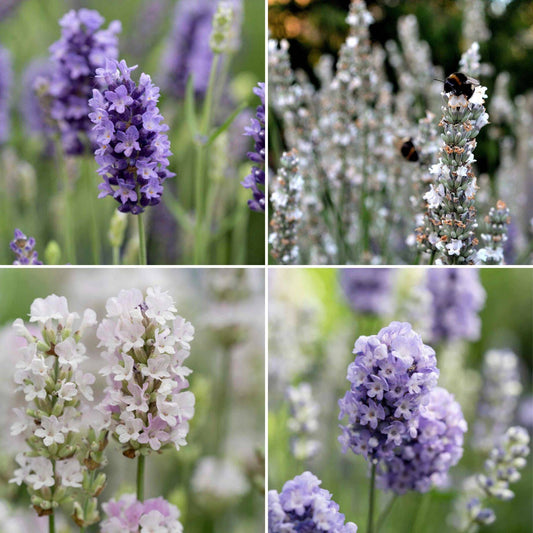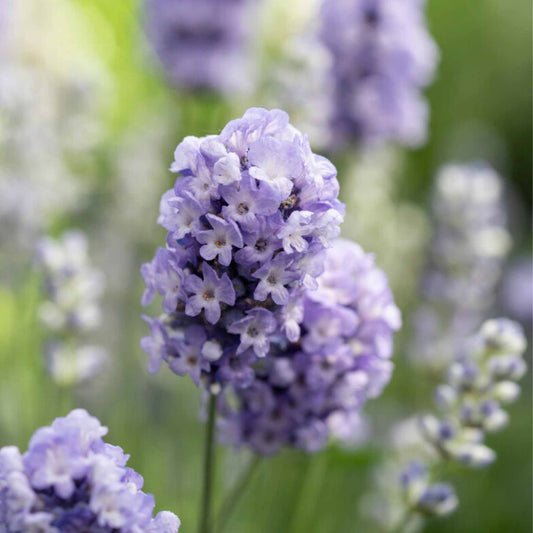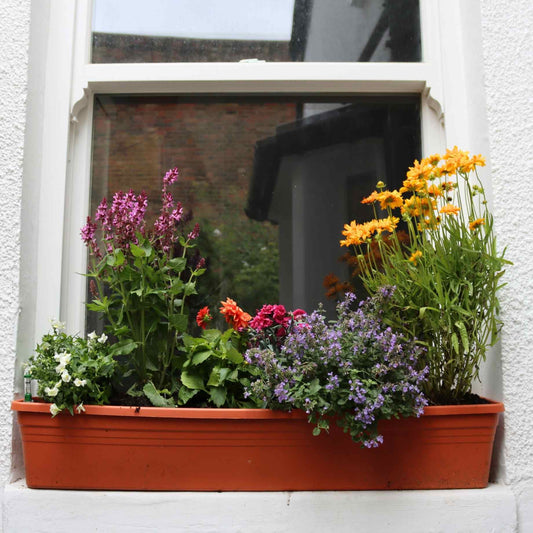Lavender Not Flowering? Your Issues Solved

Before we start, let’s make one thing clear – what we’re going to be discussing here are the exceptions and not the rule. Generally speaking, lavender plants are tougher than your grandad’s old leather boots, but even the happiest, healthiest plants become a little under the weather from time to time. So, don’t worry, you probably won’t ever have to deal with the issues discussed below, but this guide is here in those rare events that you do.
Jump to:
- Why is my lavender not flowering?
- Is my lavender dead?
- Why is my lavender dying from the bottom up?
- Why is my lavender plant turning grey?
- Why is my lavender plant drooping?
- What diseases and pests affect lavender?
Why is my lavender not flowering?
Lavenders are among the very best flowering perennial plants when it comes to their blooms, so it’s no wonder that a lack of flowers might leave you feeling, well, a little miffed. There are lots of reasons why your lavender might not be flowering, including the following:
- Overwatering
- An excess of nitrogen
- Not enough sun
- It’s not the right time!
- Transplant shock
Overwatering
Lavender plants are native to hot, dry climates like the Mediterranean and the Levant, so they tend to do best in dry, sandy soils. If you give your lavender too much water or it’s planted in heavy, clay soil that drains poorly, then you may experience issues with flowering down the line.
The first sign of an overwatered lavender plant are wilting, yellow or brown leaves. So, if you notice these and you’ve been watering your plant vigorously recently, it’s worth dialling that back a bit to see if it makes a difference.

Excess nitrogen
If your lavender plant has fabulous foliage but few flowers, then an excess of nitrogen might well be the culprit. All plants need an adequate supply of nitrogen to help facilitate photosynthesis – the process by which plants convert sunlight into energy. Too much, however, and the plant puts it to use producing more foliage.
Not enough sun
I’ll admit, I get pretty grumpy and miserable when there’s a lack of sun, and lavender plants are no different. They’re real sun-loving plants, which, again, is no real surprise when you consider the hot, dry conditions of the regions from which they originate.
If you plant your lavender in shade, then you’re just not going to get the kind of flower growth you would by planting it somewhere that it receives at least 6-8 hours of sunlight per day. That said, some lavender varieties can tolerate partial shade, and a bit of afternoon shade can, in fact, be beneficial in protecting the plant from the most intense sunlight.
But if it’s plonked in your garden’s darkest corner – that part so dark you’re scared to venture too closely to – then don’t be surprised when your plant’s flower growth is middling to poor (to non-existent).

Incorrect time of year
Alas, much though everybody would love lavender plants to flower all year round, they do not. Lavender’s flowering season varies depending on the variety. Both English lavenders (Lavandula angustifolia) and French lavenders (Lavandula stoechas) usually bloom from the end of spring or the start of summer for a month or so.
If you have a grievance with your lavender plant for not already being in full bloom by March, or that it’s not still sending up fat flower spikes at the end of October, then that’s something you’ve got to take up with the botanical gods, we’re afraid!
Transplant shock
If you’ve recently moved your lavender plant – perhaps from the garden into a container, or vice versa – then it might undergo something known as transplant shock. This is where the plant’s sensitive roots become stressed when a plant is disrupted and moved.
Signs of transplant shock include yellowing foliage, leaf drop and, of course, a reduction in (or complete absence of) flowering. To mitigate against transplant shock, move the plant on a dry day and dig with care using a garden fork, making sure you don’t cut through the plant’s roots as you do so.
Is my lavender dead?
The short answer, probably not. The long answer? Well, parts of your plant might be dead or dying, and this deadwood – typified by stems that snap easily and have no give to them – can simply be cut off with some loppers or pruning shears.
Lavenders can also appear dead when, in fact, they’re actually just still dormant from the winter period. Be patient, give the plant time and it should return with a vengeance come the springtime. Some years, they might take a little longer than others if the temperatures don’t warm up as rapidly, but hey? Good things come to those who wait…
Why is my lavender dying from the bottom up?
Without meaning to sound like a fragrant broken record, the reason your lavender might be dying from the bottom up is similar to why it might not be flowering very well – overwatering or a lack of drainage. The problem stems in the roots, which can start to rot when surrounded by overly wet soil.
You can nip this problem in the bud (is that a pun? Probably not…) by:
- Lifting your lavender out of the ground;
- Washing the rootball;
- Removing the affected, rotting roots with sterilised shears or secateurs;
- Letting the remaining healthy roots dry out a bit, trimming some of the plant’s stems – remember, after all, that you’ve just cut away some of the roots servicing the plant;
- And then replanting in new, well-draining soil.
This should hopefully have your plant bouncing back in a matter of weeks.
My lavender plant is turning grey
Now, some lavender plants naturally have grey-green foliage but that’s not really what we’re talking about here. We’re talking about when the stems and flowers turn a greyish hue. There’s not necessarily an immediate need to Panic! at the Flower Bed, though, because with just a bit of detective work you should be able to find out what’s going on.
The most likely causes? Frost damage or fungal disease. Although some lavender types, like English lavenders, for instance, are known for being cold hardy, other types (like Italian, French and Spanish varieties) are less so, and may therefore be damaged by frosty cold snaps. Even hardier lavenders can still find their growth gets a little damaged and grey if frosts are severe.
To prevent your lavender going grey from frost damage, prune your plant properly, apply a generous layer of mulch around the plant’s base in winter and cover with a horticultural fleece. If you’ve got a particularly tender variety, then your best bet for protecting it against the cold is actually to move it indoors until the spring.
To reduce the risk of grey patches caused by fungal disease, ensure your plant is situated in freely-draining soil and ensure there’s plenty of space around your plant to allow for good circulation. Don’t overwater it, and when you do water, try to do so at the plant’s base rather than over the foliage itself.
For more information on growing lavender, check out our comprehensive guide.
Why is my lavender plant drooping?
Nobody likes a droopy lavender, it’s just one of those sad, sad sights in life; like seeing a kid have their Mr Whippy ice cream stolen by a greedy gull, or Jack for some reason not getting on the floating door with Rose when there was clearly room.
But what causes it to droop? Well, there are a few main causes, the first of which is our old friend overwatering. Too much water can cause the plant’s stems to droop, but so too can underwatering your lavender. When it comes to watering your lavender plant, it’s very much a case of Goldilocks’ porridge – it has to be just right.
Another potential cause is growing your lavender in too small a container. If the pot you plant your lavender in is too small, then this will stymie root growth, which as a result can lead to weaker growth and droopy, leggy stems.
The final reason your lavender might be drooping is a lack of sunlight. As we’ve already alluded to, lavenders like a lot of sun and a lack thereof can lead, not only to reduced flowering, but weaker stem growth and, therefore, general droopiness (second only to General Grievous, of course).
Lavender problems (diseases and pests)
Lavender plants don’t typically have many issues with pests or disease, but there are still a few to watch out for, because preparedness is key when it comes to dealing with any plant problems, whether that be lavender or anything else.
Shab
This frustrating fungal disease (caused by Phoma Lavandulae) is most commonly seen in big planting blocks of lavender, affecting the plant’s branches first, which in turn causes the shoots to wilt and die. To prevent this, ensure good garden hygiene and avoid waterlogging your plant’s roots. If infected, however, you’ll unfortunately have to dig up the plant and burn it.
Root rot
Root rot is one of the most common problems a lavender plant can face. We’ve already touched on how to remove rotted/rotting roots – but what do they look like? They may have a black appearance (rather than healthy roots which have a very light or white colour) and also give off an unpleasant smell. Not nice.
Botrytis
A common fungal disease which plagues all manner of flowering perennials, fruits and vegetables, Botrytis cinerea causes unsightly moulds to form on foliage, fruits and flowers, and is more likely to occur in humid conditions and when circulation is poor around a plant. To deal with affected areas, remove dead or dying growth as quickly as you’re able and keep good airflow between your plants.
Rosemary beetles
Something of a misnomer given that they feed on a variety of aromatic foliage, and not just rosemary, rosemary beetles are under one centimetre long and easy to recognise thanks to their metallic green and purple casings.
The beetles, along with their plump grey larvae, feed on lavender’s leaves, however unless they’re present in truly astronomical quantities, then you should aim to tolerate their presence wherever possible. If you do want to get rid of them, we’d advise just picking them off by hand.
Froghoppers
Cuckoo spit (the liquid produced by the nymphs of froghopper insects) is annoying but it’s inherently harmless. Sure, it looks like someone’s emptied a bottle of foamy washing up liquid over your plant, but it does very little in the way of damage to your plant. If you really can’t stand the sight of the bubbly secretions, then you can wash it off with a hose.
Last updated: 05/09/2024




















